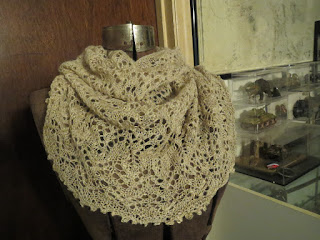Fabric having been woven and fulled--time to cut (gasp!) and sew.
I was using the pattern that alternated straight panels with rectangles. The first cut was the hardest--I was expecting it to dissolve, but the fulling held everything in place even though the fabric was still quite gauzy.
To make the triangular wedges, I cut the fabric in half diagonally, then flipped one piece so that the narrow ends were together, butted the selvedges, and used a mattress stitch to sew them together, using the Lincoln thrums for thread. Yes--I have some rippling edges there. I had sleyed the selvedges more densely so they fulled a little differently. I just smoothed them out the best I could while I was sewing.
Hint for using yarn as sewing thread: run it over a cake of beeswax - - which is a fairly common thing to do when hand sewing even with commercial thread -- but then run a dry hot iron over it to melt the wax into the yarn. It's stronger and smoother and even easier to use.
I folded the diagonal edges over about 1/2", then overlapped the selvedge edge of the straight pieces and sewed with a running stitch down both sides. This covered all the raw edges. As I had 5 straight pieces alternating with 4 wedges, this took awhile. I listened to Neil Gaimen read his Graveyard book, and also took this time to make some dye samples.
Fortunately my work table is where I can also keep an eye on my stove. I knew I wanted to make trim for all the edges of the cape (for appearance, and to protect those openweave edges). I had thought about cardweaving, which would be more authentic--but this cape is pure fantasy. Cardweaving is slower and produces a thicker band; using the loom would be faster. I picked out the pattern called "Walls of Troy" because I like the interlocking zig-zag design.
I wanted a glossy, non stretchy yarn for this so I went stash-diving again. I spun up some Leicester Longwool, but I wanted a fairly tightly spun yarn and this wool became quite wiry. Diving deeper, I found a bag of Cotswold that had been given to me--like the Lincoln, about 15 years or more ago. While also a fairly coarse wool, it was softer than the longwool but still had the high shine that I wanted. The Lincoln samples didn't go to waste, though, because I used them for my dye samples. Different types of wool will take dye differently, but the longwools will be quite similar.
I really had no idea of what colors I wanted for the trim. I wanted it to define the edges, but not be the star of the show. So I simply dyed a bunch of colors and then auditioned them against the cape fabric. My technique for sampling is to use mason jars and 10 grams of yarn or fiber. Four of those will fit in a pot (alas--my pot that was big enough for 5 sprung a leak). I fill the pot about halfway with water, bring it all to a boil, and then let it sit until cool.
I chose to use the green (second from the left) and a lighter version of the copper (sixth from the right). I used the Dharma acid dyes: the green was gold ocher and black in a proportion of 7:3, at .9% depth of shade. The copper was gold ocher and violet in a proportion of 9:1 at a 1% depth of shade.
So at this point the work schedule was going to my studio when I had a reasonable length of time to sew, run dye samples, and listen to Gaimen. During TV watching time in the evening, I combed and spun the Cotswold. The trim took almost 500 yards of yarn.
I wove about 12 yards of trim. Putting that length of warp on a loom at only 1 inch wide and keeping the yarns from slipping is, well, impossible. I didn't even try. What I did was to rig up my warping trapeze, toss my warp over it, and tied it to plastic cup with 1 1/2 pounds of weight in it. (That took sampling--1 pound was too light and 2 pounds was too heavy) That way I could weave about 5 feet before retying the warp down further. This turned out to be a brilliant way to weave. This little loom has only about a 5-6" weaving depth before you have to advance the warp--but all I had to do was crank it on; no releasing the break and no resetting the tension each time.

I enjoy weaving but have to admit that this got a bit tedious at 20 ends and picks per inch. So I would weave for awhile and sew for awhile. I couldn't even listen to audiobooks while weaving because I had to focus on the pattern. When I had finished sewing the cape pieces together, I cut off enough of the woven trim to start sewing the top and side pieces on when I needed to take a weaving break.
I think I looked at this view forever.







































